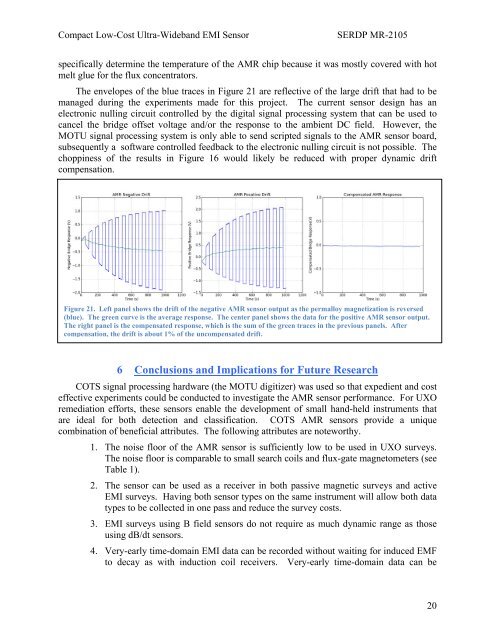Final Report - Strategic Environmental Research and Development ...
Final Report - Strategic Environmental Research and Development ...
Final Report - Strategic Environmental Research and Development ...
You also want an ePaper? Increase the reach of your titles
YUMPU automatically turns print PDFs into web optimized ePapers that Google loves.
Compact Low-Cost Ultra-Wideb<strong>and</strong> EMI SensorSERDP MR-2105specifically determine the temperature of the AMR chip because it was mostly covered with hotmelt glue for the flux concentrators.The envelopes of the blue traces in Figure 21 are reflective of the large drift that had to bemanaged during the experiments made for this project. The current sensor design has anelectronic nulling circuit controlled by the digital signal processing system that can be used tocancel the bridge offset voltage <strong>and</strong>/or the response to the ambient DC field. However, theMOTU signal processing system is only able to send scripted signals to the AMR sensor board,subsequently a software controlled feedback to the electronic nulling circuit is not possible. Thechoppiness of the results in Figure 16 would likely be reduced with proper dynamic driftcompensation.Figure 21. Left panel shows the drift of the negative AMR sensor output as the permalloy magnetization is reversed(blue). The green curve is the average response. The center panel shows the data for the positive AMR sensor output.The right panel is the compensated response, which is the sum of the green traces in the previous panels. Aftercompensation, the drift is about 1% of the uncompensated drift.6 Conclusions <strong>and</strong> Implications for Future <strong>Research</strong>COTS signal processing hardware (the MOTU digitizer) was used so that expedient <strong>and</strong> costeffective experiments could be conducted to investigate the AMR sensor performance. For UXOremediation efforts, these sensors enable the development of small h<strong>and</strong>-held instruments thatare ideal for both detection <strong>and</strong> classification. COTS AMR sensors provide a uniquecombination of beneficial attributes. The following attributes are noteworthy.1. The noise floor of the AMR sensor is sufficiently low to be used in UXO surveys.The noise floor is comparable to small search coils <strong>and</strong> flux-gate magnetometers (seeTable 1).2. The sensor can be used as a receiver in both passive magnetic surveys <strong>and</strong> activeEMI surveys. Having both sensor types on the same instrument will allow both datatypes to be collected in one pass <strong>and</strong> reduce the survey costs.3. EMI surveys using B field sensors do not require as much dynamic range as thoseusing dB/dt sensors.4. Very-early time-domain EMI data can be recorded without waiting for induced EMFto decay as with induction coil receivers. Very-early time-domain data can be20
















